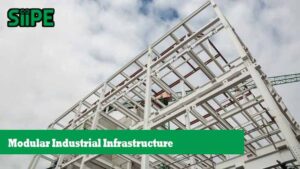As industrial zones continue to expand and modernize, the demand for efficient, reliable, and sustainable energy systems grows significantly. In this context, the smart grid emerges as a transformative solution that can redefine how energy is produced, distributed, and consumed. Implementing smart grid systems in industrial zones is not only a leap toward greater efficiency and energy savings, but also a critical step toward industrial decarbonization, resilience, and digital transformation.
What is a Smart Grid?
A smart grid is an advanced electrical grid system that uses digital technologies, sensors, and automated control to optimize the generation, transmission, and consumption of electricity. Unlike traditional grids, which rely on centralized control and one-way energy flow, smart grids support two-way communication, real-time monitoring, and intelligent automation.
In industrial zones, smart grids allow factories, warehouses, and utility providers to manage energy dynamically, respond to load changes instantly, and integrate renewable energy sources effectively.
Why Implement Smart Grids in Industrial Zones?
Industrial zones are energy-intensive environments. From large-scale manufacturing plants to logistics hubs, energy reliability and cost-efficiency are vital to maintain productivity and competitiveness.
Here’s why smart grids are particularly valuable in these settings:
1. Improved Energy Efficiency
Smart grids use sensors and AI-based analytics to monitor energy usage in real time. This allows industries to identify inefficiencies and reduce unnecessary energy consumption.
2. Reduced Downtime and Outages
Automated fault detection and self-healing capabilities in smart grids mean fewer blackouts and faster recovery from disruptions—critical for industries that operate 24/7.
3. Integration of Renewable Energy
Industrial parks can incorporate solar panels, wind turbines, and energy storage systems. A smart grid manages the variability of renewables, ensuring a stable energy supply.
4. Cost Optimization
With real-time pricing and demand response capabilities, businesses can shift energy-intensive operations to off-peak hours and benefit from lower tariffs.
5. Enhanced Sustainability
Smart grids help industries reduce their carbon footprint by optimizing energy usage and enabling the transition to cleaner energy sources.
Key Components of a Smart Grid in Industrial Settings
Implementing a smart grid involves a combination of infrastructure, technology, and intelligent systems:
▪ Smart Meters and Sensors
Installed at critical points across the power system, smart meters track energy usage in detail, allowing for transparent billing and consumption analytics.
▪ Advanced Distribution Management System (ADMS)
ADMS offers real-time control and visualization of the grid, allowing for load balancing, outage detection, and predictive maintenance.
▪ Energy Storage Systems (ESS)
Battery storage helps industrial zones store excess renewable energy and use it during peak hours or outages.
▪ Demand Response Platforms
These systems automatically adjust or shift energy loads based on grid conditions and energy prices, improving flexibility.
▪ Communication Networks (IoT & 5G)
Reliable and fast communication infrastructure ensures seamless data flow between grid components for real-time monitoring and control.
Implementation Steps
To effectively implement a smart grid in an industrial zone, a systematic approach is essential. Here’s a high-level roadmap:
1. Assessment and Planning
-
Conduct an energy audit to understand current consumption patterns.
-
Identify key objectives: efficiency, cost savings, sustainability, or reliability.
-
Map out infrastructure needs and potential renewable energy sources.
2. Stakeholder Engagement
-
Collaborate with utility providers, industrial tenants, technology vendors, and regulatory bodies.
-
Establish shared goals and cost-sharing models.
3. Infrastructure Upgrade
-
Install smart meters, communication systems, and automation equipment.
-
Upgrade substations and transformers to support two-way energy flows.
4. Platform Deployment
-
Deploy a central control system (e.g., ADMS, SCADA).
-
Integrate demand response, predictive analytics, and load forecasting tools.
5. Testing and Optimization
-
Run pilot projects to test system stability and identify improvements.
-
Continuously optimize algorithms based on performance data.
6. Scale and Integrate Renewables
-
Expand the system to accommodate rooftop solar, wind, or hybrid microgrids.
-
Implement battery energy storage for load shifting and backup.
Real-World Examples
● Jurong Island Smart Grid (Singapore)
This industrial area integrates smart meters, demand response systems, and advanced data analytics to enhance energy reliability for petrochemical industries.
● Smart Industrial Park in Shenzhen (China)
Combines AI-powered grid management with solar energy and energy storage, serving tech companies and electronics manufacturers.
● Fujairah Smart Industrial Zone (UAE)
Designed to be fully smart, this zone incorporates microgrid systems, smart lighting, waste-to-energy technologies, and advanced water recycling integrated with grid systems.
Challenges in Implementation
While smart grids offer vast potential, certain challenges must be managed:
◼ High Capital Costs
Initial investment in smart technologies and infrastructure upgrades can be substantial, especially for developing regions.
◼ Cybersecurity Risks
With increased connectivity comes increased risk of cyberattacks. Strong encryption, firewall protection, and continuous monitoring are essential.
◼ Complexity of Integration
Integrating legacy equipment with new smart systems requires careful planning, retrofitting, and sometimes full replacement.
◼ Regulatory and Policy Hurdles
Smart grid deployment often requires supportive regulations related to data privacy, energy pricing, and renewable integration.
The Future of Smart Grids in Industrial Zones
The rise of Industry 4.0, digitalization, and climate concerns make smart grids not just beneficial—but essential. In the future, we can expect:
-
Greater use of AI and machine learning for predictive grid management.
-
Adoption of blockchain for transparent and secure energy transactions between industrial tenants.
-
Emergence of peer-to-peer energy trading within industrial zones.
-
Widespread electrification of industrial fleets and integration with the grid for smart charging and load balancing.
Implementing smart grids in industrial zones is a game-changer. It transforms traditional, rigid power systems into dynamic, intelligent networks that empower industries to thrive sustainably. From cost savings and energy efficiency to carbon reduction and operational resilience, the smart grid paves the way for a new era of industrial development.
By investing in smart grid technologies today, industrial zones can future-proof their operations and lead the transition to cleaner, smarter, and more adaptive industrial ecosystems.











